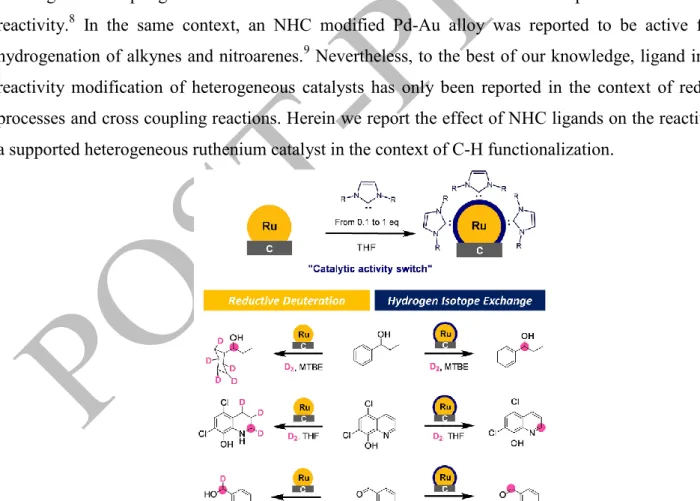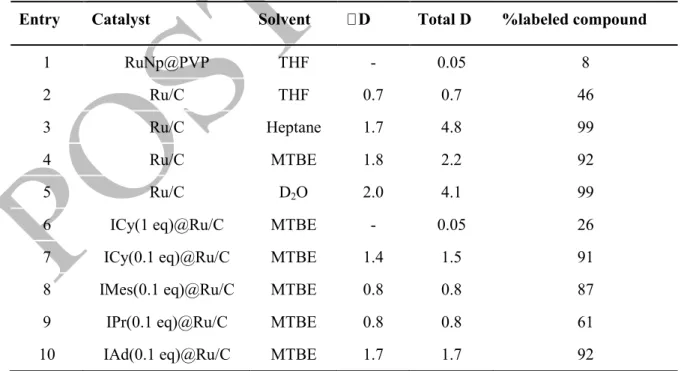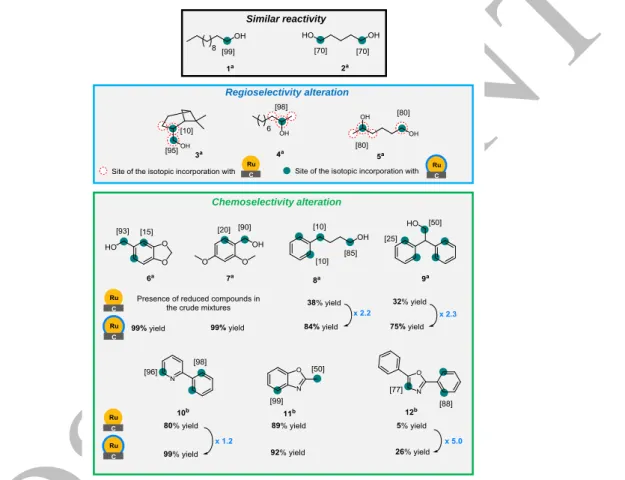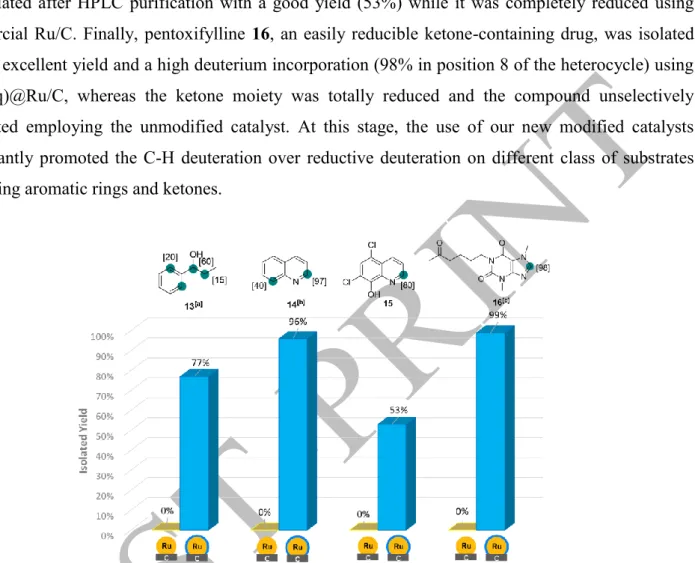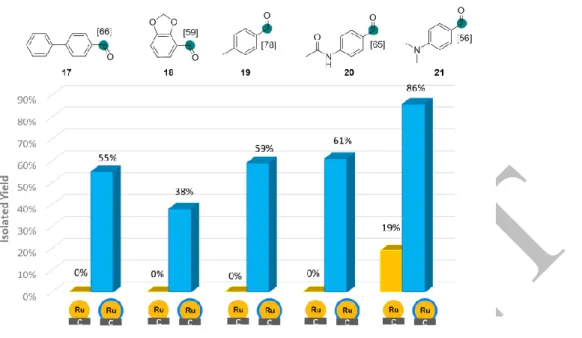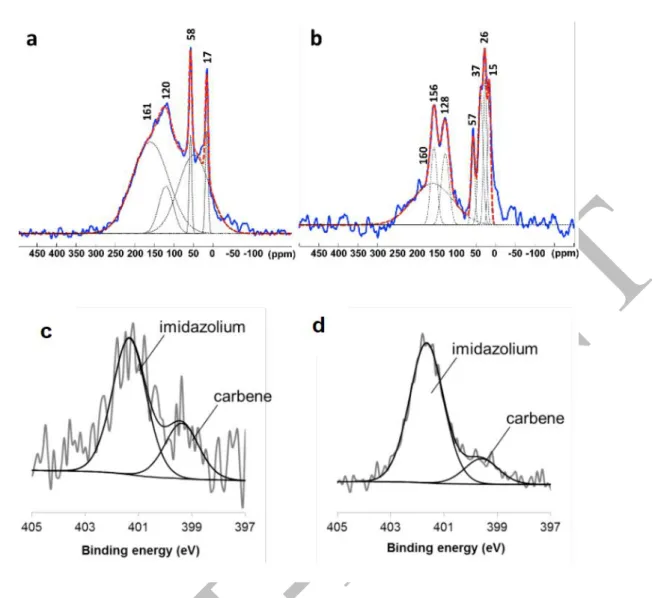HAL Id: hal-03001484
https://hal.archives-ouvertes.fr/hal-03001484
Submitted on 15 Jan 2021HAL is a multi-disciplinary open access archive for the deposit and dissemination of sci-entific research documents, whether they are pub-lished or not. The documents may come from teaching and research institutions in France or abroad, or from public or private research centers.
L’archive ouverte pluridisciplinaire HAL, est destinée au dépôt et à la diffusion de documents scientifiques de niveau recherche, publiés ou non, émanant des établissements d’enseignement et de recherche français ou étrangers, des laboratoires publics ou privés.
N-Heterocyclic Carbene Ligands for C–H Activation
Reactions
Alberto Palazzolo, Timothée Naret, Marion Daniel-bertrand, David-alexandre
Buisson, Simon Tricard, Bruno Chaudret, Philippe Lesot, Yannick Coppel,
Sophie Feuillastre, Grégory Pieters
To cite this version:
Alberto Palazzolo, Timothée Naret, Marion Daniel-bertrand, David-alexandre Buisson, Simon Tricard, et al.. Tuning the Reactivity of a Heterogeneous Catalyst using N-Heterocyclic Carbene Ligands for C–H Activation Reactions. Angewandte Chemie International Edition, Wiley-VCH Verlag, 2020, 59 (47), pp.20879-20884. �10.1002/anie.202009258�. �hal-03001484�
Tuning the Reactivity of a Heterogeneous Catalyst using N-Heterocyclic Carbene
Ligands for C-H Activation Reactions
Alberto Palazzolo,[a] Timothée Naret,[a] Marion Daniel-Bertrand,[a] David-Alexandre Buisson,[a] Simon
Tricard,[b] Bruno Chaudret,[b] Philippe Lesot,[c] Yannick Coppel,[d] Sophie Feuillastre[a] and Grégory Pieters*,[a]
[a] Université Paris-Saclay, SCBM, CEA, F-91191, Gif-sur-Yvette, France.
[b] LPCNO, Université de Toulouse, UMR 5215 INSA-CNRS-UPS, 135, Avenue de Rangueil, F-31077 Toulouse, France. [c] ICMMO, RMN en Milieu Orienté, UMR CNRS 8182, Université Paris-Saclay, Bât. 410, F-91405 Orsay cedex, France. [d] Laboratoire de Chimie de Coordination (LCC), CNRS, 205 route de Narbonne, BP44099, F-31077 Toulouse Cedex 4,
France.
ABSTRACT:
We report in this communication the dramatic impact of the addition of N-heterocyclic carbene (NHC) ligands on the reactivity and selectivity of heterogeneous Ru catalysts in the context of C-H activation reactions. Using a simple and robust protocol, we have prepared a series of new air stable catalysts starting from commercially available Ru on carbon (Ru/C) and differently substituted NHCs. Associated with C-H deuteration processes, depending on Ru/C-NHC ratios, the chemical outcome can be controlled to a large extent. Indeed, tuning the reactivity of the Ru catalyst with NHC has allowed: i) to increase the chemoselectivity and the regioselectivity for the deuteration of alcohols in organic media; ii) to synthesize fragile pharmaceutically relevant deuterated heterocycles (azine, purine) otherwise completely reduced using unmodified commercial catalysts; iii) to discover a novel reactivity for such heterogeneous Ru catalysts: the selective C-1 deuteration of aldehydes.
Corresponding author: E-mail: gregory.pieters@cea.fr Supporting information: Supporting information available
Keywords: C-H activation, Heterogeneous catalysis, Isotopic exchange, N-heterocyclic carbine, Deuterium
ORCID numbers :
The functionalization of non-activated C-H bonds is one of the most studied topics in the current chemical research.1 This strong interest is due to the numerous advantages of the direct functionalization of such non-reactive bonds leading to straightforward syntheses.2 A plethora of homogeneous transition metal catalysts have been developed until now in the field of C-H activation. Heterogeneous catalysts, despite their advantages over homogeneous ones such as their higher robustness and easier recyclability, are generally less employed to activate C-H bonds on complex molecules. This fact is probably due to the challenge related to the modulation of heterogeneous catalyst reactivity by organic ligands.3 In contrast, for other types of important chemical reactions such as hydrogenations, the addition of ligands to influence the reactivity of heterogeneous catalysts has been known for decades.4 In spite of the fact that N-heterocyclic carbenes (NHCs) are widely applied as ligands in homogeneous catalysis,5 only recently, Glorius et al. reported their capability to tune the reactivity and selectivity of a heterogeneous Ru catalyst (Ru/K-Al2O3).6 In this example, the addition of
several equivalents of NHCs to the catalyst permitted the selective hydrogenation of the alkyne over the phenyl moiety in phenylacetylene.7 Later, the same group described a Pd/Al2O3-catalyzed
Buchwald-Hartwig cross-coupling reaction in which the addition of NHCs allowed an important enhancement of reactivity.8 In the same context, an NHC modified Pd-Au alloy was reported to be active for the hydrogenation of alkynes and nitroarenes.9 Nevertheless, to the best of our knowledge, ligand induced reactivity modification of heterogeneous catalysts has only been reported in the context of reduction processes and cross coupling reactions. Herein we report the effect of NHC ligands on the reactivity of a supported heterogeneous ruthenium catalyst in the context of C-H functionalization.
Figure 1: Schematic preparation of the NHCs modified Ru on carbon catalysts and examples of catalytic activity switchs observed.
The addition of various amount of NHCs on commercially available Ru/C allows to control the reaction outcome (see figure 1). This includes the nature of the major product and the chemo/ regio-selectivity of C-H deuteration processes on various substrates such as alcohols, pharmaceutically relevant heterocyles and aldehydes. In most cases, the use of the commercial Ru catalyst led to a mixture of products arising from both reductive deuteration and Hydrogen Isotope Exchange (HIE). In contrast, the catalyst modification using NHCs promotes the HIE over the reduction.
The effect of the NHC modification on the reactivity was first carried out using alcohols as substrate for which no deuteration in organic media has been described so far using HIE.10 In this context, we have recently reported the efficacy of ruthenium nanoparticles (RuNps) to perform HIE on bioactive compounds.11 However here, the use of RuNp@PVP as catalyst (5, 10 and 20 mol%, see SI, Table S1, page 6) and deuterium gas (2 bar) as isotopic source resulted in a very poor isotopic incorporation on dodecanol 1 (Table 1, entry 1). Undecane, possibly coming from the substrate’s decarbonylation, was observed by GC-MS analysis. The subsequent CO poisoning of the catalysts surface may thus be responsible for the low deuterium incorporation observed. To overcome this problem other catalytic systems were screened (see Table 1 entry 2 and SI Table S1).
Table 1: Initial screening of conditions, catalysts and ligands for the H/D exchange on 1-dodecanol. αD: number of deuterium atoms incorporated at the alpha position of the alcohol moiety. Total D: Total number of deuterium atoms incorporated in 1-dodecanol. ICy: 1,3-dicyclohexyl-1H-imidazol-3-ium-2-ide; IMes: 1,3-dimesityl-1H-imidazol-3-ium-2-ide; IPr: 1,3-diisopropyl-1H-1,3-dimesityl-1H-imidazol-3-ium-2-ide; IAd: 1,3-di(adamantan-1-yl)-1H-imidazol-3-ium-2-ide. Conditions: 1-dodecanol (0.2 mmol), catalyst (20 mol%), D2 (2 bar), solvent (0.1M), 55 °C, 24h.
Entry Catalyst Solvent Total D %labeled compound
1 RuNp@PVP THF - 0.05 8
2 Ru/C THF 0.7 0.7 46
3 Ru/C Heptane 1.7 4.8 99
4 Ru/C MTBE 1.8 2.2 92
5 Ru/C D2O 2.0 4.1 99
6 ICy(1 eq)@Ru/C MTBE - 0.05 26
7 ICy(0.1 eq)@Ru/C MTBE 1.4 1.5 91
8 IMes(0.1 eq)@Ru/C MTBE 0.8 0.8 87
9 IPr(0.1 eq)@Ru/C MTBE 0.8 0.8 61
10 IAd(0.1 eq)@Ru/C MTBE 1.7 1.7 92
Commercially available Ru/C (5 wt%) gave the highest deuterium uptake per molecule (0.7 D) while Pd/C, Pt/C, Rh/C and Ir/CaCO3 all showed very poor reactivity in the same conditions (see SI Table
S1). Thus, optimization of the reactional conditions were performed using Ru/C as catalyst. Regarding the solvent scope (see Table 1, entries 2-5), the best compromise between the maximum deuterium incorporation and the regioselectivity of the labelling at the α-position was obtained by using MTBE (entry 4, 2.2 D incorporated, 90% of the labelling at the α position). Using apolar solvents such as cyclohexane or heptane led to efficient but unselective deuteration of the aliphatic chain (entry 3). In contrast with other results reported in the literature, using D2O as solvent also led to unselective
deuterium incorporation (4.1 D, entry 5).10a Despite such promising preliminary results, our approach did not allow a complete α regioselective deuteration of 1-dodecanol. We decided therefore to explore the potential effect of the addition of NHCs at the surface of the catalyst on the regioselectivity of this HIE reaction.12 The addition of one equivalent of ICy on Ru/C (relative to Ru) totally suppressed the deuterium uptake in 1-dodecanol (entry 6). This result suggested the existence of a strong interaction between the ligand and the catalyst. Decreasing the amount of ICy to 0.5 equivalents did not significantly change the reaction outcome (see SI, Table S1). Instead, a further decrease to 0.1 equivalents, led to a noticeably higher deuteration (1.5 D, entry 7) of 1-dodecanol with a good regioselectivity in favor of the α position and a deuterium uptake in the same range as the one obtained using unmodified Ru/C. To reach a complete deuteration along with a total regioselectivity other NHC ligands were therefore screened (entries 8-10). Finally, IAd(0.1 eq)@Ru/C13 gave the highest isotopic enrichment and α regioselectivity for the deuteration of 1-dodecanol. We investigated then the effect of some common additives like Cs2CO3 and KOtBu on the reaction outcome. Although difficult to
rationalize, the use of the latter produced a quantitative deuteration of 1-dodecanol 1 combined with a complete α regioselectivity (Figure 2).
The expansion of the scope using different aliphatic alcohols as substrates was systematically performed comparing results obtained with modified and commercial ruthenium catalysts. No significant difference was observed in the case of diol 2, contrary to alcohols (3-5) where deuterium uptake occurred with a higher regioselectivity using IAd(0.1 eq)@Ru/C. The regioselectivity of the deuterium incorporation first determined by the analysis of 1H NMR spectrum, was then confirmed using 2H-{1H} 1D NMR spectroscopy @14.1 T (see SI), evidencing the substantial enhancement of regioselectivity afforded by the presence of NHCs at the surface of the Ru catalyst. Regarding the chemoselectivity, activity switches have been first evidenced using compounds 6 to 9 as substrates. Indeed, for those molecules bearing reducible phenyl moieties, the use of Ru/C led to the desired labelling but also to the reductive deuteration whereas the use of IAd(0.1eq)@Ru/C led mainly to HIE. This difference in terms of chemoselectivity might be explained by the steric hindrance conferred by the adamantyl moiety of the ligand, limiting thus the approach of the phenyl ring to the catalytic surface. Puzzled by the observed selectivity, we next compared the catalytic activities of both ruthenium catalyst
for the labelling of easily reducible pharmaceutically relevant heterocycles. The differences in terms of isolated yields between the use of native Ru/C and IAd@Ru/C were rather small in the case of 2-phenyl pyridine 10 (99% vs 80%) and 2-methyl benzoxazole 11 (92% vs 89%). More interestingly, in the case of 2,5-diphenyloxazole 12 the effect of the catalyst modification was much more important as the isolated yield was five times higher (26% vs 5%). The effect of the NHC-modification on the reactivity of Ru/C catalyst was even more pronounced for compounds 13 to 16 for which a higher ratio NHC/Ru had to be used to favor C-H deuteration processes over the reduction of the aromatic rings (Figure 3).
Figure 2: Illustration of catalytic activity switches in the context of the deuterium labelling of aliphatic alcohols and N-heterocycles. Conditions: (a) IAd(0.1 eq)@Ru/C or Ru/C (20 mol%), 55°C, D2 (2 bar), 24 h, MTBE (0.1
M), KOtBu (1 or 2 eq); (b) IAd(0.1 eq)@Ru/C or Ru/C (5 mol%), 55°C, D2 (1 bar), 24h, THF (0.1 M). Isotopic
enrichments are indicated in brackets.
Indeed, benzylic alcohol 13 was completely reduced using Ru/C (see SI, page 63). By contrast, using a NHC:Ru ratio of 1:1 (IAd(1 eq)@Ru/C) allowed the labelling of such fragile compound with a good deuterium incorporation (1.3 D) and an acceptable yield (77%). Inspired by this result, we applied the same catalyst for the deuteration of the easily reducible quinoline 14. The compound was totally reduced with the Ru/C catalyst but only labelled with a high yield and a high isotopic enrichment (80% at the α-position of the nitrogen atom) using IAd(1 eq)@Ru/C. Interestingly, using 2 or 3 equivalents of IAd ligand did not drastically change the reaction outcome while using 0.5 equivalents (or less) of IAd
Regioselectivity alteration
Chemoselectivity alteration
led to an increase of the amount of reduced products formed (see SI page 70, Figure S94). Thereafter, we demonstrated the synthetic usefulness related to the use of such modified catalysts with the deuteration of fragile pharmaceuticals. Chloroxine 15, a quinoline based antibiotic, was also deuterated and isolated after HPLC purification with a good yield (53%) while it was completely reduced using commercial Ru/C. Finally, pentoxifylline 16, an easily reducible ketone-containing drug, was isolated with an excellent yield and a high deuterium incorporation (98% in position 8 of the heterocycle) using IAd(1eq)@Ru/C, whereas the ketone moiety was totally reduced and the compound unselectively deuterated employing the unmodified catalyst. At this stage, the use of our new modified catalysts significantly promoted the C-H deuteration over reductive deuteration on different class of substrates possessing aromatic rings and ketones.
Figure 3: Illustration of the dramatic impact of the addition of NHC (1 eq) on the chemical outcome in the context of the deuteration of easily reducible compounds 13 to 16. Conditions: IAd(1 eq)@Ru/C or Ru/C (5 mol%), 55°C, D2 (1 bar), 24h, THF (0.1 M). [a] KOtBu (1 eq). [b] Room temperature instead of 55°C. [c] 16h
instead of 24h.
The potential of such catalyst modification to discover novel C-H activation processes has been demonstrated using aromatic aldehydes as substrates (see Figure 4). Indeed, electron-rich benzaldehydes (17-19) were efficiently labelled with IAd(1 eq)@Ru/C in acceptable yields whereas the use of commercial Ru/C catalyzed the reductive deuteration of C=O along with the C-H deuteration at the α position of the resulting alcohols.
Figure 4: Deuterium labelling of aldehydes. Conditions: IAd(1 eq)@Ru/C or Ru/C (5 mol%), 55°C, D2 (1 bar),
16h, THF (0.1 M).
Interestingly, only the aldehydic proton was selectively exchanged (no traces of side-labelling was detected in the aromatic parts even using a 92.1 MHz 2H-{1H} NMR spectrometer equipped with a 2H cryogenic probe) in contrast with the recently described method using an homogeneous Ir catalyst.14 Electron-poor 4-acetamidobenzaldehyde 20 was also labelled with a good deuterium uptake and with limited reduced side-product. 4-Dimethylaminobenzaldehyde 21 was specifically used to determine the favored HIE position between formyl and amine groups. Surprisingly, only the aldehydic proton was exchanged using the NHC-modified catalyst while commercial Ru/C conduced to strong reduction and side-position labellings. In order to confirm the coordination of the NHC IAd to the surface of the catalyst, the synthesis of 13C-labelled IAd ligand has been performed (see SI page 106 for experimental details). Using this isotopically labelled carbene, modified catalysts with 0.1 and 1.0 eq of NHC has been prepared and solid-state 3C NMR analyses performed. Through 13C Hahn-echo experiment with short relaxation delay (see Figures 5a-b and SI), a broad signal centered at ca. 160 ppm was detected for the two modified catalysts which can be attributed to NHC species coordinated at the surface of the Ru catalyst. Its relaxation behavior characterized by short T2 is very likely related to the presence of
conduction electrons on the Ru particles that leads to a small Knight shift.15
Furthermore, for 0.1 eq of NHC, 13C signals at 120 ppm, 58 and 17 ppm were observed, corresponding to the sp2-hybridized carbons and to carbons of residual solvent (THF and t-BuOH). For 1 eq of NHC, 13C signals can be seen at 128 and in the 40-20 ppm area. Through a NMR investigation (see SI, page 109-112), the 128 ppm signal was assigned to the protonated NHC (imidazolium) and the 40-20 ppm ones to adamantane.16 The modified catalysts were also characterized using X-ray
Figure 5: 13C Hahn-echo MAS NMR spectra (relaxation delay of 0.5 s) of 13C-labelled along with the signals
deconvolution and the 13C chemical shifts: (a) IAd(0.1 eq)@Ru/C and (b) IAd(1 eq)@Ru/C. XPS spectra at the
N1s edge of: (c) IAd(0.1 eq)@Ru/C and (d) IAd(1 eq)@Ru/C.
photoelectron spectroscopy (XPS). The XPS spectra showed two superimposed peaks in the N1s area (see Figures 5c-d). The first peak at 399 eV corresponds to a carbenic nitrogen species while the second one at 402 eV can be attributed to imidazolium species.17 The presence of imidazolium can be explained by the reprotonation of the carbene ligand: considering that the Ru/C surface is rapidly saturated with NHC, the unreacted fraction is then reprotonated under air to give back the imidazolium. Peaks deconvolution for IAd(0.1 eq)@Ru/C showed a contribution of 28% for the NHC and 72% for the imidazolium. Instead, for IAd(1 eq)@Ru/C the contribution were respectively 15% for NHC and 85% for imidazolium (Figure 5d). In IAd(0.1 eq)@Ru/C, there is thus 0.1 0.28 = 0.03 eq of NHC bound to the surface, while in IAd(1 eq)@Ru/C, there is 1 0.15 = 0.15 eq of NHC at the surface, thus 5 times more. The switch in reactivity between IAd(0.1 eq)@Ru/C and IAd(1 eq)@Ru/C could therefore be explained by an increased competition between the substrate coordination and the one of the NHC ligands, in addition to possible physicochemical interactions of the imidazolium in excess. Based on
these data, we propose that the regio- and chemo-selectivity switches can be explained by structural effects due to the bulkiness of the IAd substituents of the NHC. Indeed, the NHC coordination at the surface of the Ru catalyst might prevent the substrate to approach particles sites responsible for the catalytic reductive deuteration processes (faces of the particle) whereas the catalysis of C-H deuteration processes, which can occur on other sites (edges or corners), is less influenced.18
In conclusion, we have demonstrated for the first time in the context of C-H activation reactions, that the addition of NHCs to a heterogeneous catalyst can have a dramatic impact on its reactivity. Depending on the nature of the substrate, the amount of NHC can be adjusted in order to favor selective C-H deuteration over reductive deuteration. The modified catalysts showed enhanced regio- and chemoselectivity for the H/D exchange process and gave access to the first general method for the selective labelling of α-positions on aliphatic alcohols using organic solvents. Moreover, the use of NHC@Ru/C permit to synthesize deuterated pharmaceutically relevant compounds that cannot be obtained using the commercially available unmodified catalyst due to reduction side reactions. Finally, the potential of such strategy to discover novel C-H activation reactions has been highlighted by the deuteration of aromatic aldehydes (a type of HIE scarcely reported in the literature until now using D2
as isotopic source). As the catalyst modification is simple to implement, and several heterogeneous catalysts can be modified using this strategy, we think that this work could have a great impact on future developments for C-H activation processes.
Acknowledgements
The authors acknowledge the European Union’s Horizon 2020 research and innovation program under the Marie Sklodowska-Curie grant agreement no. 675071 for funding AP. CEA and CNRS are also thanked for financial support. We also thank Dr. Bernard Rousseau for helpful discussion, Dr. Edmond Gravel for the help in TGA measurements and Dr. Donia Bouzouita for the help in TEM analysis. We acknowledge Dr. Karen Hinsinger, Dr. Emilie Nehlig and Dr. Christophe Dugave for their support in managing the ISOTOPICS project. We thank Jérôme Esvan (CIRIMAT, CNRS, Université de Toulouse) for XPS measurements. PL thanks the CNRS for the recurrent funding of fundamental research.
References
[2] (a) J. Loup, U. Dhawa, F. Pesciaioli, J. Wencel-Delord, L. Ackermann, Angew. Chem. Int. Ed. 2019, 58, 12803; (b) Y. Wei, P. Hu, M. Zhang, W. Su, Chem. Rev. 2017, 117, 8864; (c) Y. Park, Y. Kim, S. Chang, Chem. Rev. 2017, 117, 9247; (d) J. A. Leitch, C. G. Frost, Chem. Soc. Rev. 2017, 46, 7145.
[3] For examples on homogeneous catalysts modulation: T. Gensch, M. J. James, T. Dalton, F. Glorius, Angew. Chem. Int. Ed. 2018, 57, 2296.
[4] (a) K. Hattori, H. Sajiki, K. Hirota, Tetrahedron 2000, 56, 8433; (b) K. Hattori, H. Sajiki, K. Hirota, Tetrahedron Lett. 2000, 41, 5711; (c) N. Modutlwa, H. Tada, Y. Sugahara, K. Shiraki, N. Hara, Y. Deyashiki, T. Ando, T. Maegawa, Y. Monguchi, H. Sajiki, Nucleic Acids Symp. Ser. 2009, 53, 105; (d) A. J. McCue, J. A. Anderson, Catal. Sci. Technol. 2014, 4, 272.
[5] (a) N-Heterocyclic Carbenes in Organocatalysis, Ed. A. T. Biju, Wiley-VCH, Weinheim, 2019. (b) M. N. Hopkinson, C. Richter, M. Schedler, F. Glorius, Nature 2014, 510, 485.
[6] (a) A. V. Zhukhovitskiy, M. J. MacLeod, J. A. Johnson, Chem. Rev. 2015, 115, 11503; (b) C. A. Smith, M. R. Narouz, P. A. Lummis, I. Singh, A. Nazemi, C.-H. Li, C. M. Crudden, Chem. Rev. 2019, 119, 4986. [7] (a) J. B. Ernst, S. Muratsugu, F. Wang, M. Tada, F. Glorius, J. Am. Chem. Soc. 2016, 138, 10718. (b) S.
Muratsugu, S. Kityakarn, F. Wang, N. Ishiguro, T. Kamachi, K. Yoshizawa, O. Sekizawa, T. Uruga, M. Tada, Phys. Chem. Chem. Phys. 2015, 17, 24791.
[8] J. B. Ernst, C. Schwermann, G.-I. Yokota, M. Tada, S. Muratsugu, N. L. Doltsinis, F. Glorius, J. Am. Chem. Soc. 2017, 139, 9144.
[9] P. Tegeder, M. Freitag, K. Chepiga, S. Muratsugu, N. Moller, S. Lamping, M. Tada, F. Glorius, B. J. Ravoo, Chem. Eur. J. 2018, 24, 18682.
[10] (a) T. Maegawa, Y. Fujiwara, Y. Inagaki, Y. Monguchi, H. A. Sajiki, Adv. Synth. Catal. 2008, 350, 2215; (b) S. K. S. Tse, P. Xue, C. W. S. Lau, H. H. Y. Sung, I. D. Williams, G. Jia, Chem. Eur. J. 2011, 17, 13918; (c) E. Khaskin, D. Milstein, ACS Catal. 2013, 3, 448; (d) B. Chatterjee, C. Gunanathan, Org. Lett. 2015, 17, 4794. (e) W. Bai, K.-H. Lee, S. K. S. Tse, K. W. Chan, Z. Lin, G. Jia, Organometallics 2015, 34, 3686. [11] (a) G. Pieters, C. Taglang, E. Bonnefille, T. Gutmann, C. Puente, J.-C. Berthet, C. Dugave, B. Chaudret, B.
Rousseau, Angew. Chem. Int. Ed. 2014, 53, 230; (b) C. Taglang,L. M. Martinez-Prieto, I. del Rosal, L. Maron, R. Poteau, K. Philippot, B. Chaudret, S. Perato, A. Sam Lone, C. Puente, C. Dugave, B. Rousseau, G. Pieters, Angew. Chem. Int. Ed. 2015, 54, 10474; (c) L. Gao, S. Perato, S. Garcia-Argote, C. Taglang, L. M. Martinez-Prieto, C. Chollet, D.-A. Buisson, V. Dauvois,P. Lesot, B. Chaudret, B. Rousseau, S. Feuillastre, G. Pieters, Chem. Commun. 2018, 54, 2986; (d) A. Palazzolo, S. Feuillastre, V. Pfeifer, S. Garcia-Argote, D. Bouzouita, S. Tricard, C. Chollet, E. Marcon, D.-A. Buisson, S. Cholet, F. Fenaille, G. Lippens, B. Chaudret, G. Pieters, Angew. Chem. Int. Ed. 2019, 58, 4891; V. Pfeifer, M. Certiat, D. Bouzouita, A. Palazzolo, S. Garcia‐ Argote, E. Marcon, D-A. Buisson, P. Lesot, L. Maron, B. Chaudret, S. Tricard, I. del Rosal, R. Poteau, S. Feuillastre, G. Pieters, Chem. Eur. J. 2020, doi:10.1002/chem.201905651.
[12] Deuteration experiments with other ligands notably phosphines have been performed. In same experimental conditions, the best results was obtained with 0.025 eq of dppb ligand leading to an isotopic enrichment of 28% at the α-position of the alcohol moiety and with traces of labelling on the aliphatic chain. Those results are far below the results obtained using NHC ligands especially IAd (92 % of isotopic enrichment at the α-position and no side labelling).
[13] Loadings of both catalysts IAd(1eq)@Ru/C and IAd(0.1 eq)@Ru/C have been estimated by TGA measurements (see SI page 114 Figure S156).
[14] W. J. Kerr, M. Reid, T. Tuttle, Angew. Chem. Int. Ed. 2017, 56, 7808.
[15] P.-K. Wang, J.-P. Ansermet, S. L. Rudaz, Z. Wang, S. Shore, C. P. Slichter, J. H. Sinfelt, Science 1986, 234, 35.
[16] According to NMR investigations (see SI, page 109-112) the sharp peak at 158 ppm might be attributed to the presence of NHC fragments coming from the degradation of the free NHC ligand.
[17] (a) A. Ruhling, K. Schaepe, L. Rakers, B. Vonhoren, P. Tegeder, B. J. Ravoo, F. Glorius, Angew. Chem. Int. Ed. 2016, 55, 5856; (b) L. M. Martinez-Prieto, I. Cano, A. Marquez, E. A. Baquero, S. Tricard, L. Cusinato, I. del Rosal, R. Poteau, Y. Coppel, K. Philippot, B. Chaudret, J. Campora, P. W. N. M. van Leeuwen, Chem. Sci. 2017, 8, 2931; (c) L. M. Martinez-Prieto, E. A. A. Baquero, G. Pieters, J. C. Flores, E. de Jesus, C. Nayral, F. Delpech, P. W. N. M. van Leeuwen, G. Lippens, B. Chaudret, Chem. Commun. 2017, 53, 5850. [18] (a) Note that TEM analyses of native and modified catalysts have demonstrated that the global morphology
of the Ru nanoparticles are not affected by the NHC modification (see SI page 113 Figure S155); (b) for reference relative to the effect of faces congestion of Ru nanoparticles on the reduction of arenes see for example: E. Bonnefille, F. Novio, T. Gutmann, R. Poteau, P. Lecante, J.-C Jumas, K. Philippot, B. Chaudret, Nanoscale 2014, 6, 9806.
